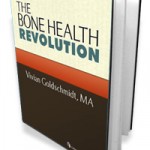
Answer:
When almonds digest, they leave an alkaline “ash” in the body, which helps to alkalize the blood. Since blood must maintain an alkaline pH level of about 7.4 for optimum health, alkaline foods are an essential part of our diet. If the pH of the blood becomes acid by eating acidifying foods, the body may leach calcium from the bones to neutralize the acid, thereby weaking the bones. For more information on the benefits of an alkaline diet, check out my article on my Top 10 Bone-Building Foods.
Tags: alkaline diet, osteoporosis

Answer:
You might feel like drinking, but don’ t do it. Alcohol interferes with the healing of fractures and will slow your recovery.
Tags: alcohol, broken bone, fracture healing, osteoporosis
Answer:
According to Merck, the pharmaceutical company that manufactures Fosamax, osteoporosis is “a systemic disease characterized by low bone mass and microarchitectural deterioration of bone, with a consequent increase in bone fragility and susceptibility to fracture.” (2001) The problem with this definition is that a person with high bone density may fracture, while another with low bone density may never fracture. Low bone density is only one of many risk factors associated with osteoporosis. In fact, bone flexibility is more important than bone density, but it’s not as easy to measure.
Tags: bone density, bone flexibility, Merck, osteoporosis
 If you’re like me, cold weather crimps your style. When Jack Frost moved into the neighborhood, I huddled indoors, away from freezing temperatures and nature’s withered appearance, until I began to feel depressed and lifeless myself. This year I decided to beat the winter blues. I talked to friends, searched my soul, and surfed the Internet to find ways to spend a happy, healthy winter season. Following these Top 10 tips has lifted the fog from my cloudy mood!
If you’re like me, cold weather crimps your style. When Jack Frost moved into the neighborhood, I huddled indoors, away from freezing temperatures and nature’s withered appearance, until I began to feel depressed and lifeless myself. This year I decided to beat the winter blues. I talked to friends, searched my soul, and surfed the Internet to find ways to spend a happy, healthy winter season. Following these Top 10 tips has lifted the fog from my cloudy mood!
1) Pray for God’s help to focus on the upside–the good things that are happening around you–rather than the downside of winter. While there may be no flowers blooming or butterflies floating on a balmy breeze, neither are there mosquitos to bite you or bees to sting you. Allergies are minimal. The grass doesn’t need mowing. Think positive!
2) Take hot showers. After washing and warming up thoroughly, improve the efficiency of your body’s thermostat by alternating hot and cold showers for the last few minutes–30 seconds as hot as you can take it, and then 30 seconds as cool as you can comfortably stand. End on the cold water shower to close your pores and keep in your body heat.
3) Dress brightly! During winter people tend to dress in browns and grays and blacks to match their surroundings, but dressing darkly can be depressing in itself. Dressing warmly in reds, blues, yellow, greens, and even whites and pastels can brighten your mood–and that of those around you–the way spring flowers do.
4) Eat healthy, warming foods. We’re naturally inclined to eat soups, stews, and heavier foods in winter. Why not give heartier fare a healthy boost with immune-boosting ingredients, such as garlic, onions, and shiitake and maitake mushrooms. Avoiding sugar and caffeine, though. Caffeine tends to make the body lose water, and processed sugar puts a strain on the pancreas and sets up an environment in the colon that is susceptible to candida yeast invasion.
5) Force yourself to go outside. Get light and fresh air everyday. Deep breathe. No, it’s not as much fun for us warm-weather people to spend time outdoors in the cold, but our bodies are happier and healthier if we do!
6) Moisturize. Drink more water. Drink hot teas and soups. Hydrate and moisturize your skin after showers and when needed throughout the day. You may not feel as thirsty during the winter as you do during summer, but your body still needs 6-8 glasses of water for optimum health.
7) Make sure you keep moving. Stretch, lift weights, walk, run, go to the gym, work out at home with exercise DVD’s…whatever it takes to keep the body strong and flexible.
8) Grow indoor plants. Although outdoor plants appear shriveled and lifeless, your home can be filled with the indoor beauty of a wide variety of colorful houseplants.
9) Do” indoor” things that stimulate your creativity and vitality. Visit museums and art galleries, go to concerts and films, hang out with friends and go shopping. Go to Barnes & Noble to read, drink some hot tea, and take home a new book. Go out for dinner. Find ways to entertain yourself at home. Winter is a perfect time for playing an instrument, taking photos, doing crafts, and writing letters.
10) Avoid stress by adjusting your schedule as needed. Don’t strain to make your winter schedule match your summer schedule. After all, summer days have about four more hours of sunlight than winter days do! So, work when you can. Sleep when you can. Exercise when you can. Pray when you can. Be flexible and open to changes in timing. Sometimes those changes can be just what you need to tune up your day and feel great!
Be blessed!
Kathy
Tags: bone health, osteoporosis, SAD, seasonal affective disorder
 Distance added today was 1 mile from an after-dinner walk with my husband.
Distance added today was 1 mile from an after-dinner walk with my husband.
Want to join me in our Walk Around the World? All you need to do is tell me in a Comment (below) the Teammate Name you would like to use, and I’ll add you to Team Osteodiet.com. You’ll receive a Password that you can use to enter your own miles on the WATW tracking chart. It’s that easy! And remember, you can use the fitness activity chart and step converter found on the Walk Around the World launch page to calculate the equivalent distance of a wide variety of physical activities, from gardening to swimming to chopping wood to housework! You’ll be one step closer to bone strength and overall health.
 Today I began keeping track of my fitness activities on our “Walk Around the World” tracker, posting 2.1 miles for Day 1. Here’s how it worked:
Today I began keeping track of my fitness activities on our “Walk Around the World” tracker, posting 2.1 miles for Day 1. Here’s how it worked:
My fitness activities today included 30 minutes of upper body weight training and a one-mile walk at a moderate pace. According to the fitness activity chart, each minute of weight training (moderate) = 87 steps, so 30 minutes times 87 steps = 2610 steps total. Using the Steps to Miles Calculator, I entered my average stride length of 2.3 feet and the 2610 steps, and then I clicked “Submit.” My 30-minute workout turned out to be equal to 1.1 miles. That, plus my one-mile walk, gave me 2.1 miles for the day, which I just entered on the tracker.
Want to join me? Just write me back in the comments section below, telling me what “Teammate Name” you would like to use. I’ll add you to Team OsteoDiet.com, and you’ll receive a Password so that you can post your own mileage on the WATW tracking chart . It’s that easy!
Enjoy!
Kathy
Tags: bone health, osteoporosis, Walk Around the World, weight bearing exercise
 A friend from the National Osteoporosis Foundation Support Group sent me the name of a book by Vivian Goldschmidt about building bone health naturally. Entitled The Bone Health Revolution, the book is available online for $29.95 plus shipping. I’ve ordered a copy and will report to you about it after I have read it. In the meantime, if you want to read a free sample chapter from the book, you can click on this link:
A friend from the National Osteoporosis Foundation Support Group sent me the name of a book by Vivian Goldschmidt about building bone health naturally. Entitled The Bone Health Revolution, the book is available online for $29.95 plus shipping. I’ve ordered a copy and will report to you about it after I have read it. In the meantime, if you want to read a free sample chapter from the book, you can click on this link:
http://saveourbones.com/free-chapter.html
Tags: bone health, Books, dangers of bisphosphonate drugs, osteoporosis, Vivian Goldschmidt
